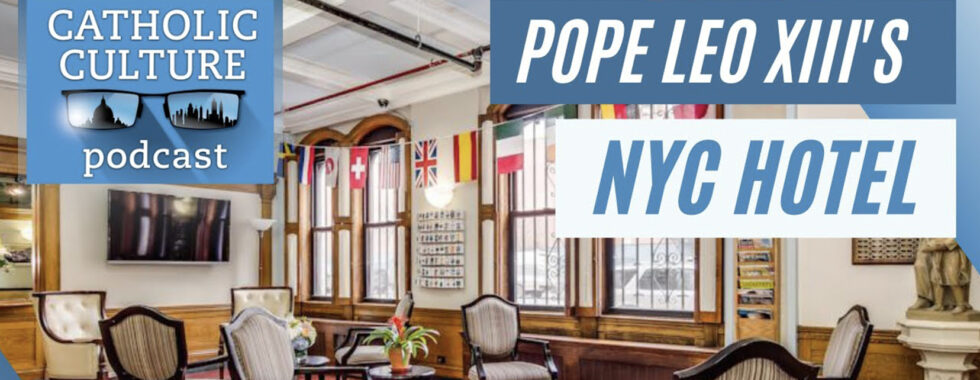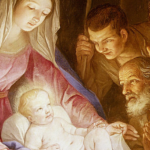Pope Leo XIII’S NYC Hotel
Learn more about Pope Leo XIII’s NYC Hotel through this podcast recently published by Thomas V. Mirus from The Catholic Culture. In the podcast, he interviews President and Chairperson of The Leo House, Michael Coneys, and Executive Director of The Leo House, Ashley Bryant. You’ll enjoy learning about the long-standing history of The Leo House in New York City dating back to 1889.
The Catholic Culture Podcast #103 Pope Leo XIII’s NYC Hotel:
Did you know there’s a hotel in NYC named after Pope Leo XIII? The Leo House was founded in the 1880s as a boarding house for German Catholic immigrants, at the behest of the Holy Father, and is still operating today as a Catholic nonprofit hotel providing charitable hospitality at a discount.
In this episode you’ll learn from the Leo House’s chairman and president, Michael Coneys, about the hotel’s fascinating history. The story involves Pope Leo’s special care for the Catholic Church in Germany as it was struggling under Protestant Prussian rule; as well as the St. Raphael Society, which helped political dissidents to escape Nazi Germany. It also involves a very providential visit from Mother Teresa! But this is also a very contemporary story of one of many Catholic nonprofits struggling to survive the past year’s lockdowns.
Listen to this podcast on: Apple Podcasts | Google Podcasts | RSS feed | YouTube
Don’t have time to listen? Feel free to read the transcript of Pope Leo XIII’s NYC Hotel interview below:
Thomas Mirus (TM): I recently had the chance to stay at The Leo House here in manhattan. This is a guest house originally founded for German Catholic travelers to stay in, it was kind of something more like a boarding house then and more like a hotel today. It was founded at the behest of Pope Leo XIII after whom it’s named. It is also an organization that’s been struggling somewhat lately due to the pandemic and the lock-downs so I thought it would be nice to talk to these people and find out about their unique history and how they’re staying afloat. I have here with me today Michael Coneys, President and Chairperson of The Leo House. Welcome Michael, how are you today?
Michael Coneys (MC): Hi how are you today?
TM: I’m doing great. Would it be accurate to say The Leo House started as something more akin to a boarding house?
MC: Our full name is “The Leo House, a guesthouse for German Catholic Emigrants,” and it was started in 1889 with the authorization and partial funding from Pope Leo XIII to welcome German Catholic Emigrants to the United States. We were originally located on State Street across from what is today the Battery, which is Battery Park. These days you still have the Castle Garden building in Battery Park. That was the predecessor to Ellis Island. And the Leo House was right across the street. The original people, the entire staff of The Leo House was either clergy or religious sisters. The Congregation of St. Agnes has been with us since the beginning since 1889.
MC: It was founded by Peter Paul Cahensly who was a German American businessman. Since they may not speak the language, he wanted German Emigrants to find a place that could help them acclimate to life in the United States. They could stay at The Leo House but we also provided job references, language lessons and contact with German American Catholics who were already well established here in New York. At the time there was a very large German Catholic population, particularly in the Yorkville neighborhood in Manhattan. That mission changed over many years and particularly two world wars between the United States and Germany. Today we are a Catholic Guesthouse with 81 hotel-styled rooms. I also have Ashley Bryant with me, our Executive Director, who I will refer a few questions as well. Ashley is it correct that roughly one-third of our rooms have a bathroom down the hall?
Ashley Bryant (AB): Correct.
How is The Leo House Structured?
MC: Two-thirds of our rooms have an ensuite bathroom, where the bathroom is actually in the room itself. The other one-third of the rooms have a sink in the room and a water closet, but if you’d like to take a bath you’d go down the hall which is the old European style. Since 60% of our travelers pre-pandemic are from overseas and a very large number from Europe, that is still, to them, where bed-and-breakfast style lodging is common in Europe, the idea of taking a bath or shower down the hall is still quite common. We’re slowly renovating as time goes by, room by room, and most of our 8th floor is modernized now so that everything is a full ensuite bathroom. The pandemic has really hit the entire hospitality industry in the five boroughs and the whole New York City metropolitan area. Because New York City, both pre-pandemic and post pandemic, will go back to being a major attraction for travelers from all over the world.
TM: Do you find that any Germans stay because of the German Catholic history here?
All Are Welcome at The Leo House
MC: I don’t know, we don’t really advertise that so much. What we do advertise is that we are Catholic. We have a full-time priest chaplain, Father Eddie Conway, who is a Capuchin Franciscan. We have the Sisters of St. Agnes on staff.
MC: We have a Cathlic chapel with mass celebrated most days, if not by Father Eddie, by guest priests who are invited to say mass if they want to. Prepandemic, we have mass most days, nearly 7 days a week. We have Michael Lucci, who we are bringing back on staff who leads the rosary prayer in the afternoon 5 days a week. Now these are all optional. We don’t force religion down people’s throats because anybody can stay at The Leo House. You don’t have to be Catholic to stay at The Leo House. All faiths, all races, all religions, all nationalities etcetera, we welcome everyone. We take the good samaritan approach to our guests, we welcome everybody.
TM: You have a convent upstairs, don’t you?
MC: We do! We have four sisters of St. Agnes. We have Sister Marilyn, Sister Pat Hayes, Sister Vicki, and Sister Carol.
TM: Can you tell me about this congregation?
The Congregation of St. Agnes
MC: The congregation of St. Agnes was founded in the middle of the 19th century by Mother Agnes Hazatt. She agreed when one of our founders, Mr. Chicle wrote to her and ask if she would send a group of sisters to run The Leo House, she said yes. Until about the mid-80’s almost half the staff was sisters. Only slowly thereafter did it start to become almost all laypeople. The head of the dining room was a Sister, Sister Paul-Ann used to make the most wonderful fruitcakes they were wonderful. She did all the baking in The Leo House.
TM: Pope Leo XIII is one of my favorite popes. He became that for me when I began reading some of his social anticlicles last year. I’ve done some podcasts discussing his teachings. Certainly a very important pope of more or less modern times. How did it become The Leo House? What is the connection to Pope Leo XIII?
How did The Leo House become Pope Leo XIII’s NYC Hotel?
MC: I’ll try to give you a nutshell lesson on that. Before 1870 there was no such thing Germany. You had well over 100 kingdoms and principalities that all made up the whole Roman Empire. In the 1870’s you really didn’t even have a Roman Empire anymore. Napoleon the 3rd of France launched the Franco-prussian war against the kingdom of Prussian and many of the western kingdoms sided with the French unfortunately. Otto Von Bismark was king williams commander-in-chief of the army and smashed Napoleon the 3rd. The second empire was created in 1871 after the victory of Sudan. Then you suddenly have one single Germany with its capital in Berlin and under William the first.
MC: Prussia was a Lutheran kingdom and the Lutheran church came to dominate all of Germany. The Catholic church fell very hard during that time. Pope Leo XIII became extremely popular with German Catholics in the U.S. because he took to very extraordinary measures to rescue the Catholic church in Germany. You have to remember something very important about Pope Leo XIII, he was the very first pope in one thousand years who was not also the King of the papal states. Pope Pius the ninth, his immediate predecessor, he was the last pope who was also the king of the papal states. When Garibaldi defeated the papal states’ army, literally the paternium petri ceased to exist. Today we have the Vatican City which is a sovereign state and a member of the United Nations.
MC: For a fairly long period of time, the papal states ceased to exist and the Pope was not even a sovereign leader. So Pope Leo XIII had a lot on his plate. First he had to reestablish the papacy as a sovereign entity and to have other states recognize him. The German Empire did not recognize him for a very long time. He dealt successfully to reenergize the Catholic Church both in Austria-Hungary and in the German Empire. As a result, he became extremely popular with German Americans, particularly here in New York.
MC: Annually, in the United States and throughout the world you have the “Peter’s Pence” collection. I believe you’re familiar with that, I think it was just a month ago where we had the Peter’s Pence collection in all of our parishes in the Archdiocese of New York. Peter Paul Cahensly started that concept and raised a purse of $50,000 in the middle of the 1880’s. It doesn’t sound like a lot today, but if you multiply that by 20 you get an idea of what that would be like today. Cahensly and a group of German-American business people went to Rome to give this money to Pope Leo XIII to encourage him.
Pope Leo gave the money back to them. He said “I want you help Germans acclimate themselves to be able to succeed in their transition to life in the United States.” He wanted them to create a society to help them. Peter Paul Cahensly had already created the St. Raphael Society, named after the archangel Rapheal. Among many things, St. Raphael was the patron saint of travelers and particularly pilgrims. In those days you didn’t have the European Union. Everytime you went to a different country, you had to have entry visas, paperwork etc. In order to cross from Austria to Hungary you had to have a visa.
If you weren’t wealthy, there was the St. Raphael Society to help many people negotiate the different border crossings necessary to travel from one place to another in Europe. The Nazi’s decimated the St. Raphael society in Europe because they helped many people. I don’t know what the numbers were like, but they helped an enormous number of poor people. Eighty percent of their members ended up in Auschwitz. We are the only remaining chapter in New York, in the United States. The whole mission of the St. Raphael Society in Europe has changed today. It is a system of youth hostels across Europe.
MC: We’re not a hostel anymore. I would describe us more as a traditional American hotel. We’re not-for-profit and we are a charitable organization in the sense that our modern mission is that we operate fairly close to our cost levels. We don’t charge much above our break-even point for our guest rooms.
Charitable Programs
MC: We also have four different charitable programs. Our hospital and nursing home visitors hospitality program offers a low rate regardless of the room-type. This is for people coming to New York to visit patients at hospitals or residents at nursing homes. There is a clergy and religious discount for not-only Catholic clergy and religious but for clergy of all recognized denominations. The heroes hospitality program discount is 20% off our normal room rates if you are part of the active military or if you’re a first responder. We also take care of the Archdiocese of New York.
MC: If people call us directly, we will also extend free guest accommodations for people who are traveling on errands of mercy or very extreme situations which we did in the case of Ishmail. Being from Africa, there was nowhere for him to receive orthopaedic surgery for a specific situation. He stayed with us for free on his way to Shriner’s Children’s Hospital to receive corrective surgery to be able to walk on his legs again. That is my job as Chairman and President to raise money and grants to help pay for our charitable programs.
TM: Thank you for sharing that fascinating history about the German Catholic experience and Pope Leo XIII’s NYC Hotel. I am actually the descendant of German Emigrants on both sides of my grandfather’s family. Catholicism comes from my grandmother’s side. I’m fascinated with this. My earliest ancestors in the 16th century were a line of Lutheran pastors. I had the pleasure of staying at The Leo House, so I thank you for allowing me to do that. All the common spaces are very attractive and also you have a lot of art throughout the spaces. Can you tell me about the kind of art program that you have throughout The Leo House?
The Art Program at The Leo House
MC: We’ve been friends with Leo Feroleto for about the past 10 years. Leo supplies artwork that is compatible with our mission as a Catholic / Christian guesthouse. So you have a lot of fairly religious paintings and some sculptures. We had a series of Sacred Spaces sculptures that looked like places where you would pray. That has just ended. Leo has a gallery called Six Summit Gallery if you want to look it up with locations in Connecticut and a pop-up location D.C.
Stained Glass at The Leo House
MC: We have our Silver Jubilee window 1889 – 1914 celebrated our 25th anniversary. It’s a beautiful glass depiction of the Archangel Raphael leading Tobias. In the right side you have a depiction of German Catholics departing from the mother country with the help of the Catholic church and on the left hand side you see The Leo House welcoming them. At the base of the Archangel is the heraldic symbol of Pope Leo XIII. IN our chapel we also have some antique stained glass which we’ve completely renovated over the past few years. The chapel is updated. We use it quite often where the sisters hold their liturgies and group prayer sessions.
TM: You’ve had a number of famous Catholics stay at The Leo House, most prominently Mother Theresa. Can you tell me about that?
MC: If you read the book “A View From the Street” by Eileen Egan who is the biographer of Mother Theresa. She was married to a wealthy advertising executive. She traveled with Mother Teresa and helped her with her fundraising and was her companion for over 25 years. On one particular trip they came into New York. She describes coming to The Leo House on November 7th of 1960 and the story that we know in The Leo House from the Congregation of St. Agnes, because they were here to receive them, when they got to the old Kennedy airport, their original reservations had fallen through and their room had been given to someone else.
MC: So they got into a taxi and the driver said “I know just the place for you!” It was not planned at all but they came here and it was a great fit. Mother Teresa stayed in room 409 which we’ve had dedicated to her. What was interesting synergy and quite by accident, there was another Reverend Mother staying here at the same time, Mother Anna Dengel, who was the founder of the Medical Missionary Sisters, which brings healthcare to women where medical services for women are rather scarce. She was staying here at the same time. Mother Teresa and Mother Dengel had been in India at the same time but had never met, but sure enough they met at The Leo House.
The next morning they both went to mass and they were sitting one pew apart. As they were getting up to go to breakfast, they met by accident at The Leo House and ended up having breakfast together. That formed the synergy that the two orders connected and they shared a great deal of fundraising and they became lifelong friends. The Holy Spirit was guiding Mother Teresa into that taxi.
TM: Mother Dolores Hart is also associated with The Leo House.
MC: Yes! Mother Hart has become a wonderful friend of The Leo House. In the late 50’s and early 60’s she was a successful actress for Columbia pictures. One of my favorite pictures of her is when she played Saint Clare with Bradford Dilman as Saint Francis of Assisi. They form the companion order of the Poor Clares. In her first action picture “Loving You,” she was the love interest of Elvis Presley. That was his first picture and her first major picture.
MC: And Elvis was Mother Dolores’s first onscreen kiss and so she has become known as “the nun who kissed Elvis.” We have been doing an Annual Fundraising Dinner Gala and we have given an award to Mother Dolores Hart. Our third award was to Mother Dolores. We had a hiatus of one year because doing a virtual dinner gala because there is a big learning curve and we’re still learning how to do that.
Our donor base is very different from other organizations. We don’t have big banks that fund our activities. We have average, everyday people who make up our donor base. To create an online gala that would appeal to that donor base is difficult.
TM: I hope things are getting better for you. If somebody listening would like to help out, how do they do that?
MC: Sure if you go to our website, leohousenyc.org, you find the donate button on the upper right-hand side. You can make a donation right online. We’d delighted to receive donations. Our problem is that our occupancy is down around 5-10% of normal pre-pandemic rates. If we’re at 25% we’d be lucky. Normally this time of year, in April we’d be at 80-85 or even 90%. In January or February we were at around 5%. That has had a really hard strain on our finances.
TM: I hope that people will donate. If you come to New York, The Leo House, or Pope Leo XIII’s NYC Hotel, come visit this really nice area of New York City.
MC: Almost all of the restaurants in a 5 block radius are reopened for indoor dining. Broadway is scheduled to reopen in September. We’re managing to hold on by our fingernails.
TM: I trust that you will make it through. I am fascinated about how much history you went through and thank you for your hospitality while I stayed at Pope Leo XIII’s NYC Hotel.




